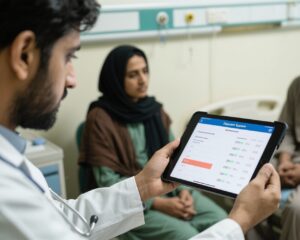Highlight
- A peer-coaching intervention in primary care increased attendance in weight management programs at 6 months.
- The intervention did not achieve statistically significant weight loss at 12 months compared with enhanced usual care.
- Peer coaches were veterans trained to deliver low- to moderate-intensity support via telephone sessions.
- The trial was conducted in a real-world VA setting and interrupted early due to the COVID-19 pandemic.
Study Background and Disease Burden
Obesity is a prevalent and chronic condition associated with increased risks of cardiovascular disease, diabetes, cancer, and premature mortality. Despite its significance, effective and accessible obesity care remains challenging in primary care settings. Barriers include limited clinician time, inadequate training, and patient-level factors such as lack of motivation or support. Peer coaching—leveraging trained individuals with shared life experiences—has emerged as a potential strategy to enhance patient engagement, provide social support, and help overcome these challenges by delivering weight management counseling.
The Department of Veteran Affairs (VA) serves a population with a high prevalence of overweight and obesity, and integrating peer coaching could provide a scalable model for addressing obesity within this context. However, rigorous evaluation of the effectiveness of peer coaching interventions on weight outcomes and program engagement in this setting is limited.
Study Design
This investigation was a 2-arm, cluster randomized clinical trial conducted from November 2017 to August 2021 at a single VA site in the United States. Primary care physicians (PCPs) and their patients were the units of randomization and analysis. Eligible patients were adults with overweight (BMI ≥25) or obesity (BMI ≥30). PCPs were randomized to two arms: the peer coaching intervention (called Peer-Assisted Lifestyle) or enhanced usual care (EUC).
Enrollment was stopped early due to the COVID-19 pandemic, which shifted the VA’s weight management services to virtual formats. The intervention included the following key components:
– Patients in the peer coaching arm completed a tablet-based, goal-setting tool.
– They received 1 in-person session and up to 12 individual telephone peer coaching sessions over 12 months.
– Peer coaches were military veterans holding at least a bachelor’s degree, trained for a minimum of 20 hours in coaching and lifestyle counseling.
Patients randomized to the EUC arm received health education materials without active coaching.
Primary and secondary outcomes were assessed at 6 and 12 months post-enrollment. The primary outcome was mean change in weight (kilograms) at 12 months. Secondary outcomes included weight change in percentage, proportion of patients achieving at least 5% weight loss, and changes in waist circumference.
Data analysis followed the intention-to-treat principle.
Key Findings
The study enrolled 20 PCPs (55% women) and 281 patients, predominately men (78.6%), with a mean age of 50.6 years and an average baseline BMI of 33.4.
At 12 months, the adjusted mean weight loss was greater in the peer coaching arm (-2.51 kg) compared with EUC (-0.79 kg), but this difference narrowly missed statistical significance (difference: -1.72 kg; P = .05).
At 6 months, statistically significant differences favored the peer coaching group:
– The proportion of patients achieving ≥5% weight loss was 16.68% versus 5.50% in EUC (difference: 11.18 percentage points; P = .03).
– Attendance at weight management programs was higher in the peer coaching group (28.68%) than EUC (13.32%) (difference: 15.37 percentage points; P = .02).
There were no reported significant adverse effects related to the intervention.
These results suggest that peer coaching positively influenced early behavioral engagement and clinically meaningful weight reduction in a subset of patients but did not translate into a statistically significant greater mean weight loss at 12 months.
Expert Commentary
This study provides valuable real-world evidence on using peer coaching as a low- to moderate-intensity intervention embedded in primary care. Engaging veterans as peer coaches leverages shared experiences to potentially enhance patient motivation and support, which likely contributed to increased program attendance and early weight loss success.
However, the modest weight loss and attenuated differences at 12 months highlight the challenges in sustaining long-term weight management and the need for more intensive or prolonged interventions in some patients. The early termination of the trial due to pandemic-related disruptions and shift toward virtual care limited the sample size and possibly the power to detect significant differences on primary outcomes.
Limitations include single-site conduction and a predominantly male veteran population, which may restrict generalizability to other populations and care settings. The level of coaching intensity was relatively low compared to some intensive behavioral weight loss programs, suggesting potential benefit from enhanced support or integration with other obesity treatments.
Nonetheless, the increased attendance at weight management programs is an important patient-centered outcome that may facilitate ongoing lifestyle improvement.
Conclusion
Employing peer coaching in primary care settings shows promise for increasing engagement in weight management programs among veterans with overweight and obesity. While a low- to moderate-intensity peer-coaching intervention did not produce statistically significant greater weight loss at 12 months compared with enhanced usual care, it significantly improved short-term program attendance and clinically important weight loss in a subset of patients.
Future research should explore optimizing peer-coach training, increasing intervention intensity or duration, and integrating coaching with telehealth to enhance scalability and long-term effectiveness, especially given the ongoing shift to virtual care precipitated by the COVID-19 pandemic.
References
1. Wittleder S, Wong L, Ruan AM, et al. Peer Coaching to Support Weight Management in Primary Care: A Cluster Randomized Clinical Trial. JAMA Netw Open. 2025;8(9):e2529136. doi:10.1001/jamanetworkopen.2025.29136
2. Jensen MD, Ryan DH, Apovian CM, et al. 2013 AHA/ACC/TOS Guideline for the Management of Overweight and Obesity in Adults. Circulation. 2014;129(25 Suppl 2):S102-S138.
3. Phelan SM, Burgess DJ, Yeazel MW, Hellerstedt WL, Griffin JM, van Ryn M. Impact of weight bias and stigma on quality of care and outcomes for patients with obesity. Obes Rev. 2015;16(4):319-326.
4. Appel LJ, Clark JM, Yeh H-C, et al. Comparative Effectiveness of Weight-Loss Interventions in Clinical Practice. N Engl J Med. 2011;365(21):1959-1968.



